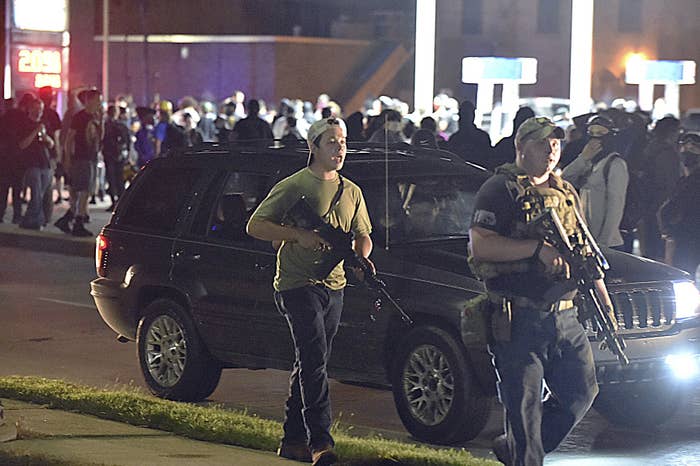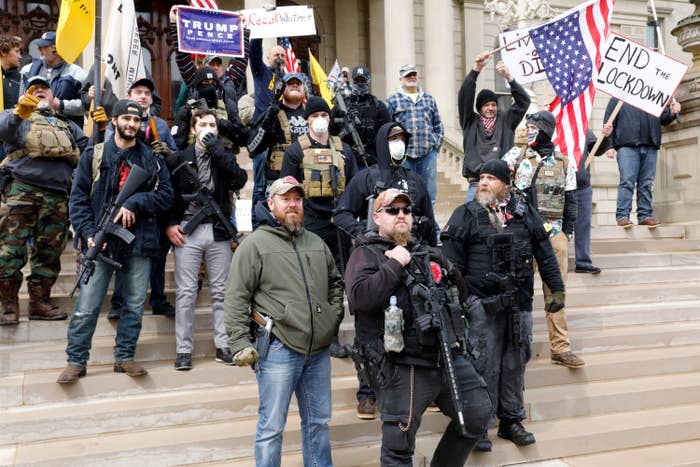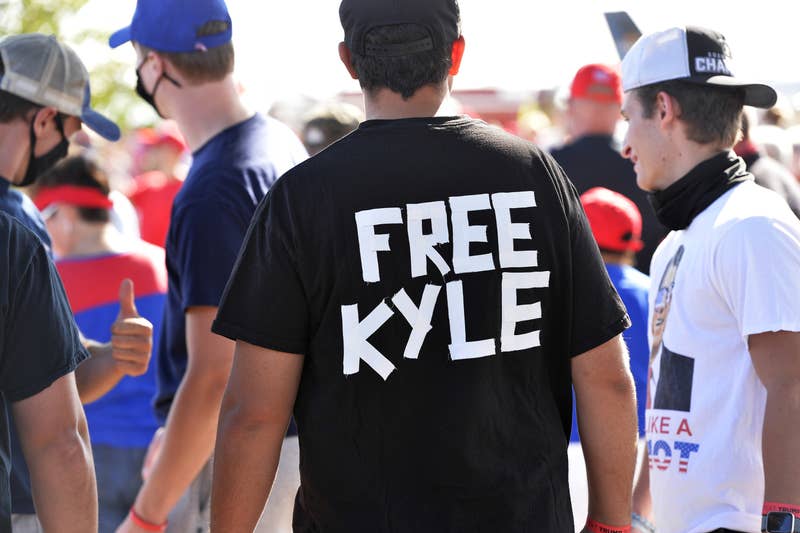“What happened in Kenosha was entirely predictable. Unfortunately, I think we’ll see more of it.”
Last updated on August 30, 2020

Adam Rogan / AP
Kyle Rittenhouse (left), with backward cap, in Kenosha, Wisconsin, Aug. 25, with another armed civilian.
The violence in Kenosha, Wisconsin this week — in which a teenage Trump supporter allegedly shot and killed two people at a Black Lives Matter rally and wounded a third — has raised a terrifying prospect: What if it is not a horrific one-off but a preview of what's to come?
What if the bitter presidential election is not decided on Election Day — a scenario many experts say is likely — and people from both sides take to the streets? What if Trump appears to lose the election but claims that the outcome was rigged and refuses to concede, a possibility that he has already floated? What if Trump loses the popular vote again but still wins the election, and protesters fill the streets, met by counterprotesters? What if it turns violent?
With the election two months away, the country’s divides have grown increasingly dangerous. Speakers at the Republican National Convention, led by the president, warned that the country is spiraling into disorder and chaos. Self-proclaimed militia members have taken to the streets across the country with guns to defend property amid protests against police brutality. An online ecosystem quickly connects and radicalizes like-minded “patriots,” as social media industry executives struggle to contain the consequences.
Now, elected leaders, police officials, and political observers are looking out at their streets and public plazas with trepidation: Could violent clashes erupt out there on Nov. 4? How bad could it get?
“It’s extremely concerning,” said Howard Graves, a senior policy analyst at the Southern Poverty Law Center. “There’s a brewing climate of hostility. Far-right groups have stated their intent to publicly demonstrate with firearms around polling locations or anywhere there is civil strife.”
“What happened in Kenosha was entirely predictable,” he added. “Unfortunately, I think we’ll see more of it.”
This spring and summer, as protests against police brutality have reached towns where no one thought they would ever come, Americans have taken to the streets like never before. The majority of these protests have been peaceful, but increasingly, in small cities and big ones, there has also been violence, or the dark threat of it. Many on the right have grown terrified by what they see on the news every night, especially on conservative media.
Armed groups of people wielding baseball bats, or machetes, or even long guns and assault weapons have begun appearing, sometimes on the fringes and sometimes in the center of the action. The reasons have varied. Sometimes, as in Richmond, Virginia, and Lansing, Michigan, it was to protest shelter-in-place orders or mask requirements. Sometimes, as in Dallas and Provo, Utah, and Douglas County, Nevada, it was to gather a show of force to counteract the perceived threat of Black Lives Matter protests and the destruction of property and burning of businesses that sometimes trailed in its wake.
Got a tip? You can email tips@buzzfeed.com. To learn how to reach us securely, go to tips.buzzfeed.com.

Jeff Kowalsky / Getty Images
An armed group at the Michigan State Capitol, on April 15, 2020, protests the governor's stay-at-home orders aimed at containing coronavirus spread.
People from both ends of the political spectrum have appeared on the streets in the last few months with guns, but right-wing protesters have made a spectacle of showing up with military-grade weapons, such as when throngs of largely white protesters, many conspicuously toting assault weapons, marched into the state capitol in Michigan. Gun ownership in America tilts heavily Republican; according to a 2017 study from the Pew Research Center, “Republican and Republican leading independents are more than twice as likely as Democrats and Democrat leaning independents to say they own a gun.”
President Donald Trump has at times condoned people who take the law into their own hands. At the Republican National Convention this week, his campaign gave a primetime speaking slot to the Missouri couple who stood on their front porch brandishing guns while Black Lives Matters protesters marched peacefully by on the way to demonstrate in front of the St. Louis mayor’s home.
In recent months, left-wing militia groups have sprouted up to protect protesters. Marq Claxton, a retired NYPD detective and director of the Black Law Enforcement Alliance, said he worries about the peril of heavily armed civilians squaring off at this tense, emotional moment.
Already, armed groups have shot or threatened protesters and even law enforcement officials. In Oakland, California, a suspected member of the "boogaloo boys," an extremist, right-wing, anti-government group — a fact that Vice President Mike Pence pointedly ignored — was arrested on charges of fatally shooting a federal officer. In Bethel, Ohio, hundreds of counterprotesters, some of them armed, confronted around 80 Black Lives Matter protesters on a peaceful summer afternoon; a melee ensued. In Bedford County, Pennsylvania, a white man allegedly shot a protester marching with a group from Wisconsin to Washington, DC.
And then there is Kenosha, where armed militia members patrolled the streets with the stated purpose of defending property and backing up law enforcement amid protests sparked by the police shooting of Jacob Blake. The militia members were organized on Facebook by a group calling itself the “Kenosha Guard” and invited “any patriots willing to take up arms” against “evil thugs.” Facebook received more than 450 reports about the page — far more than for any other event that day — but left it up. On Tuesday night, 17-year-old Kyle Rittenhouse allegedly opened fire with an AR-15, killing one man. Then, after appearing to run away, he fell down, and prosecutors say he opened fire again, killing a second man and wounding a third.
Rittenhouse was arrested Thursday and charged with murder. But not before his actions were defended by prominent figures on the right: Tucker Carlson described Rittenhouse as acting to “defend order when no one else would.” Online fundraisers sought money for his legal bills — his lawyers have said he was acting in self-defense — and hashtags called him a hero.
“We’re seeing this cultural embrace of vigilantism,” said Brian Levin, director of the Center for the Study of Hate & Extremism at California State University, San Bernardino.

Joseph Prezioso / Getty Images
A man wears a shirt calling for freedom for Kyle Rittenhouse, the 17-year-old who allegedly shot protesters in Wisconsin, during a Donald Trump campaign rally in Londonderry, New Hampshire, Aug. 28.
Vigilante groups on the right have begun to organize online this summer: quickly, passionately, and in direct response to Black Lives Matter protests or public health mandates to wear masks or stay at home. Social media giants have typically been slow to take down pages, such as the Kenosha Guard page, that appear to incite mayhem.
“There are a lot of new groups on the scene,” said Carolyn Gallaher, a professor at American University’s School of International Service who studies militia groups. “If we have an election that's contested and these groups come out in the streets, it’s going to be really hard to police because a lot of cities aren't used to dealing with this,” Gallaher added. “As a country we've allowed these groups to brazenly walk around with military-grade weapons, and we haven't policed them or reined them in.”
In some cities, many rank-and-file officers appear to tacitly support armed militia members.
In Kenosha this week, officers were captured on video praising armed militia members and thanking them for coming into the city. Some also provided them with bottles of water. Rittenhouse reportedly received one himself from police before the shooting. During the first week of protests following the police killing of George Floyd, the Oath Keepers militia in Texas and the Three Percenters militia in Utah both announced that they were collaborating with local law enforcement to help provide security services.
Some officers “sympathize with those groups, and they almost treat them as an auxiliary of the department,” said Jody Armour, a professor at the University of Southern California Law School. “The people who are tasked with maintaining order and keeping the peace in the event of a contested election and an outbreak of violence are themselves partisan.” Indeed, police unions and leaders across the country have endorsed Trump, who has lashed out at the Black Lives Matter movement and directed federal agents to crack down on protests.
Widespread election protests, in which pro-Trump officers stand between protesters who share their affinity for the incumbent and protesters who don’t, could “really test the fabric of the nation's democracy, and what it’s real relationship is with law enforcement,” Armour said.
Gallaher, the scholar who studies militias, said the vigilantes on patrol at this summer’s protests bear little resemblance to the libertarian militias operating around the US in the 1990s and 2000s, which sometimes clashed with law enforcement in high-profile stand-offs over land or tax issues. Instead, they are more akin to the pro-government paramilitary groups of recent history in Iraq, Colombia, Northern Ireland, or the Jim Crow South, “where they are formally not of the state but they have similar overlap and aims,” she said. “Paramilitaries can often do the dirty work of the state, and the state can have plausible deniability because they're not connected to them.”
And then there are the politics of the presidential election itself. As the economy sputters and COVID cases climb, President Trump has campaigned on framing cities controlled by Democrats as lawless cauldrons of chaos while painting the suburbs — and the crucial bloc of voters who live there — as communities under seige. Many of his supporters are terrified by what they see on the news every night, especially on conservative media. His campaign has made “law and order” a centerpiece, and he threatened to send federal troops into cities from Philadelphia to Chicago to Oakland.
In that sense, if Kenosha offers one future scenario, Portland, Oregon, offers another. There, mass demonstrations in the streets have been aggravated by partisan politics in a presidential election, and a conflict between local control and federal intervention ordered by President Trump.
Amid ongoing Black Lives Matter demonstrations, officers from the Department of Homeland Security moved into Portland in July and began detaining protesters in unmarked vans and shooting tear gas nightly into crowds of demonstrators, including long lines of women who proclaimed themselves a “wall of moms.”

Nathan Howard / Getty Images
A Portland police officer rips a bike from the hands of a protester while dispersing a crowd from in front of the Multnomah County Sheriffs Office in Portland, Oregon, Aug. 22.
Portland Mayor Ted Wheeler took to the streets with protesters, where he was teargassed by law enforcement and then donned goggles in front of the media while denouncing federal tactics. But despite his show of support for protesters, Wheeler has been pilloried by the left, who call him “Tear Gas Teddy,” for his apparent helplessness to control law enforcement actions in his city. Last weekend, armed protesters from both the left and the right faced off on the downtown streets, scuffling for hours while wielding weapons including paintball guns, actual guns, and metal rods. Police officers watched but made no arrests.
Wheeler, Portland’s mayor, crystallized a key problem: The city was “at a critical place where police officers are needed to intervene in protests where police officers themselves are the flashpoint.”
On Friday, Wheeler released an open letter to Donald Trump in which he blamed the president for some of the violence on the streets. “We know you’ve reached the conclusion that images of violence or vandalism are your only ticket to reelection,” he wrote. “When you sent the Feds to Portland last month, you made the situation far worse.”
Some elected officials and police leaders, perhaps wary of the volatile politics, refused to even discuss the prospect of militia violence in their streets, declining interview requests with BuzzFeed News. But other officials, including mayors in Albuquerque, New Mexico, and Missoula, Montana, have felt it necessary to publicly proclaim that they do not support armed civilians taking it upon themselves to act as police.
"We, as elected leaders from the Spokane community, declare that we oppose the presence of armed vigilantes roaming the streets of our city," read a public statement issued in June by elected leaders in that Washington state city after armed militia groups began patrolling the downtown area, alarming local business owners.
On the front lines, police officers around the country have privately told BuzzFeed News that they are growing increasingly fearful.
“It’s to the point now that we’re almost in too deep because we’ve allowed too many people to have these legitimate weapons during these riots and protests,” said an officer in Maryland, who asked not to be named for fear that speaking about the issue would put his safety at risk. “We have to toe the line very carefully because we’re up against equal firepower. Even though the police have more numbers, we aren’t trained like the military to be prepared to face shit like that on a daily basis.”

Albert Samaha is an investigative reporter for BuzzFeed News and is based in New York.

Jessica Garrison is a senior investigative editor for BuzzFeed News and is based in San Francisco.
No comments:
Post a Comment